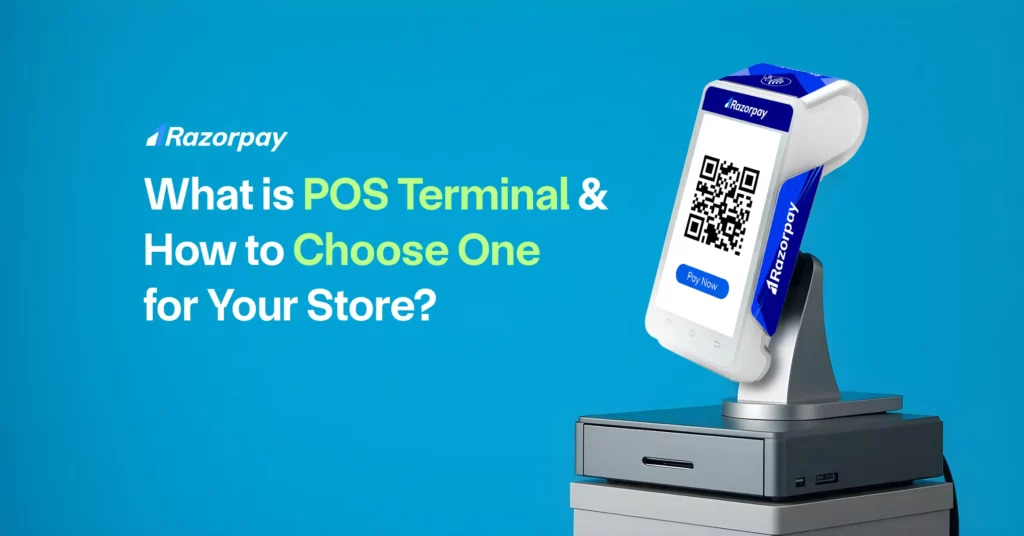Table of Contents
What is a POS Terminal?
A Point of Sale (POS) terminal is a hardware device used to process card payments and manage transactions at retail locations. Modern POS terminals go beyond basic functions and can include features such as inventory management, sales reporting, and support for various payment methods.
These terminals can range from traditional cash registers to advanced devices like smartphones with card readers, countertop terminals with barcode scanning, portable devices, and systems with contactless payment capabilities. POS terminals support credit, debit, gift card, and digital wallet payments.
They can also integrate with other essential business tools like ePOS apps and payment gateways.
Related Read: Mini POS: Smart & Compact Payment Solutions
Key Functions of a Point of Sale (POS) Terminal
A POS terminal is a vital tool for modern businesses, serving as the central hub for sales transactions. It streamlines the checkout process, captures essential data, and provides valuable insights for business operations.
Key functions of a POS terminal include:
Accepting Payments
POS terminals handle various payment methods, including credit/debit cards, UPI, and NFC-enabled wallets.
Processing Transactions
The terminal communicates with financial institutions or payment gateways to authorize and complete payments, transferring funds securely from the customer’s account to the merchant’s account.
Recording Sales Data
POS systems capture transaction details such as amount, date, time, and items purchased, aiding in inventory management, sales analysis, and accounting.
Inventory Management
Advanced POS systems update inventory levels in real-time, helping monitor stock accurately and maintain adequate inventory levels.
Receipt Generation
Receipts are issued in print or digital form, with digital options sent via email or SMS to reduce paper waste and enhance convenience.
Integration With Business Systems
POS systems can integrate with tools like accounting software, CRM systems, and barcode scanners, streamlining data sharing and improving business operations.
Related Read: What is POS Data? Meaning, Types, Benefits and How it is Collected
Types of POS Terminals
Countertop POS
Countertop POS terminals are traditional point-of-sale systems placed on a counter or checkout area. Commonly used in retail stores, restaurants, and other brick-and-mortar businesses, these terminals typically include a cash drawer, receipt printer, and a customer display.
Use Cases:
- In-store purchases
- Handling returns and exchanges
- Inventory management
- Customer loyalty programs
- Employee time tracking
Mobile POS (mPOS)
Mobile POS (mPOS) terminals are handheld devices like smartphones or tablets equipped with POS software. They offer portability and flexibility, making them suitable for various businesses.
Use Cases:
- Pop-up shops and mobile vendors
- Field service payments
- Delivery and takeout orders
- Customer signatures for proof of delivery
- Inventory management on the go
Related Read: POS vs mPOS: What’s the Real Difference?
Self-Service POS
Self-service POS terminals empower customers to complete transactions independently. These kiosks are commonly found in airports, grocery stores, and retail establishments.
Use Cases:
-
- Quick checkouts for low-ticket items
- Kiosk-based ticket purchasing (e.g., events, transportation)
- Bill payment and account management
- Product information and demonstrations
- Returns and exchanges without cashier assistance
Related Read: Difference between POS System and Cash Register
How Does a Point of Sale Terminal Work?
A point-of-sale (POS) terminal is a digital device used to process sales transactions at the point of purchase. It serves as the interface between a business and its customers, facilitating payments and capturing essential sales data.
The POS transaction process typically involves the following steps:
- Product Scanning: The cashier scans product barcodes or manually enters item details.
- Payment Processing: Customers can pay using cash, credit/debit cards, mobile wallets, or other digital payment methods.
- Transaction Authorization: The POS system communicates with payment networks to verify the customer’s payment information and authorize the transaction.
- Receipt Generation: A receipt detailing the purchase is issued to the customer, often electronically or as a printed document.
- Data Capture: The POS system records transaction data, including product information, payment details, and customer information (if provided).
Modern POS systems have evolved beyond basic transaction processing, offering features like inventory management, customer relationship management (CRM), and sales analytics. These capabilities empower businesses to make data-driven decisions and enhance overall operations.
Related Read: How to Choose a POS System?
Benefits of POS Terminals for Businesses
Improved Efficiency
POS terminals streamline sales processes, reducing wait times for customers and increasing overall efficiency. By automating tasks like inventory management and payment processing, businesses can focus on providing excellent customer service. Additionally, POS systems can help reduce human errors associated with manual calculations and cash handling.
Enhanced Customer Experience
Modern customers expect quick and convenient checkout experiences. POS terminals facilitate faster transactions, multiple payment options, and personalized interactions. Features like customer displays and loyalty programs can further enhance customer satisfaction and loyalty.
Data Analytics
POS systems generate valuable data on sales, customer behavior, and inventory levels. Businesses can utilize this data to identify trends, optimize product offerings, and make data-driven decisions.
Inventory Management
POS terminals help businesses maintain accurate inventory levels by tracking product sales and restocking needs in real-time. This prevents stockouts, reduces carrying costs, and improves overall inventory management.
Related Read: POP vs POS Explained
How to Choose the Right POS Terminal for Your Store?
Selecting the appropriate POS terminal is crucial for a business’s success. Several factors must be considered when making this decision:
1. Business Type and Size
- Retail stores: Countertop POS systems or mobile POS solutions can be suitable, depending on store size and layout.
- Restaurants: A combination of countertop and mobile POS systems might be ideal for handling dine-in, takeout, and delivery orders.
- Service-based businesses: Mobile POS systems often suffice for on-site transactions.
2. Payment Acceptance
Ensure the POS terminal can process various payment methods, including credit cards, debit cards, mobile wallets, and contactless payments. Consider integration with payment gateways for online transactions if applicable.
3. Scalability and Growth
Choose a POS system that can accommodate your business’s growth. Consider factors like the number of terminals needed, potential expansion, and integration with future technologies.
4. Features and Functionality
Prioritize features essential for your business operations. Look for inventory management, customer relationship management (CRM), employee management, and reporting capabilities.
5. Cost and Return on Investment (ROI)
Evaluate the initial POS machine charges and software costs, as well as ongoing subscription fees and transaction charges. Assess the potential return on investment by considering increased sales, improved efficiency, and reduced errors.
6. Security
A robust POS system is essential to protect sensitive customer data. Consider features like encryption, tokenization, and regular security updates.
By carefully considering these factors, businesses can select a POS terminal that aligns with their specific needs and contributes to overall business success.
Related Read: What Is a Terminal ID (TID)?
Razorpay: A Comprehensive POS Solution
Razorpay offers a robust and versatile POS terminal solution designed to meet the diverse needs of businesses. With a focus on efficiency, security, and user experience, Razorpay empowers businesses to streamline operations and enhance customer satisfaction.
Key features and benefits of Razorpay POS include:
- Seamless Payment Processing: Accept a wide range of payment options, including cards, wallets, and UPI, with fast and secure transactions.
- Comprehensive Reporting: Gain valuable insights into sales performance, customer behavior, and inventory levels through detailed reports and analytics.
- Inventory Management: Efficiently track stock levels and manage inventory to avoid stockouts and overstocking.
- User-Friendly Interface: Intuitive design ensures easy navigation and operation for both staff and customers.
- Scalability: Grow your business without limitations, as Razorpay POS can adapt to changing needs.
Whether you own a small retail store or a large-scale enterprise, Razorpay provides a tailored POS solution to drive your business success.
Ready to streamline your payment process? Discover the advanced features of Razorpay POS and boost your business efficiency. Visit Razorpay POS now!
Related Read: What is an EPOS System: Types, Components and How Does it Work?
Frequently Asked Questions (FAQs)
1. What is POS’s full form?
POS stands for Point of Sale. It refers to the location of a transaction, typically a retail store or an online platform.
2. What are examples of POS terminals?
A few examples of POS terminals include traditional countertop terminals, mobile POS systems, self-service kiosks, Razorpay POS machines, and the ePOS app.
3. What types of businesses use POS terminals?
Businesses like retail stores, restaurants, hotels, supermarkets, and e-commerce platforms use POS terminals.
4. Are POS terminals different from cash registers?
Yes, POS terminals are more advanced than traditional cash registers. They offer additional features like inventory management, sales reporting, and integration with other business tools like payment gateways and accounting software.
5. How secure are POS terminals for processing payments?
POS terminals have advanced security features to ensure secure payment processing. They encrypt sensitive customer data and comply with industry standards such as PCI-DSS.
6. Can POS terminals integrate with other business systems?
Modern POS systems can integrate with various business systems, such as inventory management software, customer relationship management (CRM) tools, loyalty programs, and accounting software.
7. What is the cost associated with implementing POS terminals?
The cost of implementing a POS terminal depends on various factors, such as the type of system chosen, the business’s specific requirements, the initial purchase or lease of the terminal, installation fees, and staff training.
8. Are there any ongoing fees or maintenance costs for POS terminals?
Yes, there are usually ongoing fees associated with using a POS terminal. These may include transaction fees, monthly subscriptions, and additional features or support charges.
9. Can POS terminals accept various payment methods, including contactless payments?
Modern POS terminals are designed to accept several payment methods, including credit cards, debit cards, mobile wallets like UPI and PayTM, and contactless payments using NFC technology.



